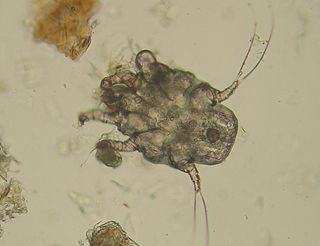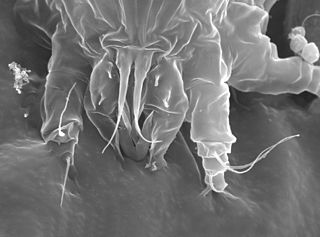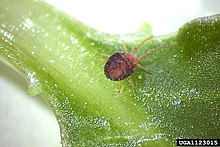
Mites are small arachnids. Mites span two large orders of arachnids, the Acariformes and the Parasitiformes, which were historically grouped together in the subclass Acari. However, most recent genetic analyses do not recover the two as each other's closest relative within Arachnida, rendering the group non-monophyletic. Most mites are tiny, less than 1 mm (0.04 in) in length, and have a simple, unsegmented body plan. The small size of most species makes them easily overlooked; some species live in water, many live in soil as decomposers, others live on plants, sometimes creating galls, while others again are predators or parasites. This last type includes the commercially destructive Varroa parasite of honey bees, as well as scabies mites of humans. Most species are harmless to humans, but a few are associated with allergies or may transmit diseases.

The peacock mites of the genus Tuckerella are a significant herbivorous pest in the tropics, for example on citrus fruit. Other species dwell in grasses, possibly as root feeders.

Tarsonemus is a genus of trombidiform mites within the family Tarsonemidae.

Astigmatina is a clade of mites in the superorder Acariformes. Astigmata has been ranked as an order or suborder in the past, but was lowered to the unranked clade Astigmatina of the clade Desmonomatides in the order Sarcoptiformes. Astigmatina is now made up of the two groups Acaridia and Psoroptidia, which have been suborders of the order Astigmata in the past. Astigmatina contains about 10 superfamilies and 76 families under Acaridia and Psoroptidia.

Eriophyoidea are a superfamily of herbivorous mites. All post-embryonic instars lack the third and fourth pairs of legs, and the respiratory system is also absent.

The Prostigmata is a suborder of mites belonging to the order Trombidiformes, which contains the "sucking" members of the "true mites" (Acariformes).
The Raphignathoidea is a superfamily of the Acari (mite) order Trombidiformes, comprising 1087 species in 62 genera and 12 families.

Endeostigmata is a suborder of acariform mites. There are about ten families in Endeostigmata. The grouping is strongly suspected to be paraphyletic, containing unrelated early diverging lineages of mites.

The Trombidiformes are a large, diverse order of mites.

Parasitengona is a group of mites, variously ranked as a hyporder or a cohort, between the taxonomic ranks of order and family.

Histiostoma is a genus of mites in the family Histiostomatidae.
The family Ameroseiidae is one of the three families of mites under the superfamily Ascoidea. There are about 12 genera and more than 130 described species in Ameroseiidae. The family has a worldwide distribution.
Antennoseius is a genus of mites in the family Ascidae. As of 2021, it comprised 59 species mostly in subgenera Antennoseius and Vitzthumia, as well as six species not assigned to a subgenus.
Acaricis urigersoni is a species of mite.
Neophyllobius is a genus of mites.

Eupodoidea is a superfamily of mites in the order Trombidiformes. There are about 8 families and more than 160 described species in Eupodoidea.

Trombidioidea is a superfamily of mites in the order Trombidiformes. There are about 8 families and at least 430 described species in Trombidioidea.

Petrobia is a genus in Tetranychidae, containing 34 described species. It includes some pest species.

Hydryphantoidea is a superfamily of mites in the order Trombidiformes. There are about 6 families and more than 250 described species in Hydryphantoidea.
Anystoidea is a superfamily of mites in the order Trombidiformes.
















